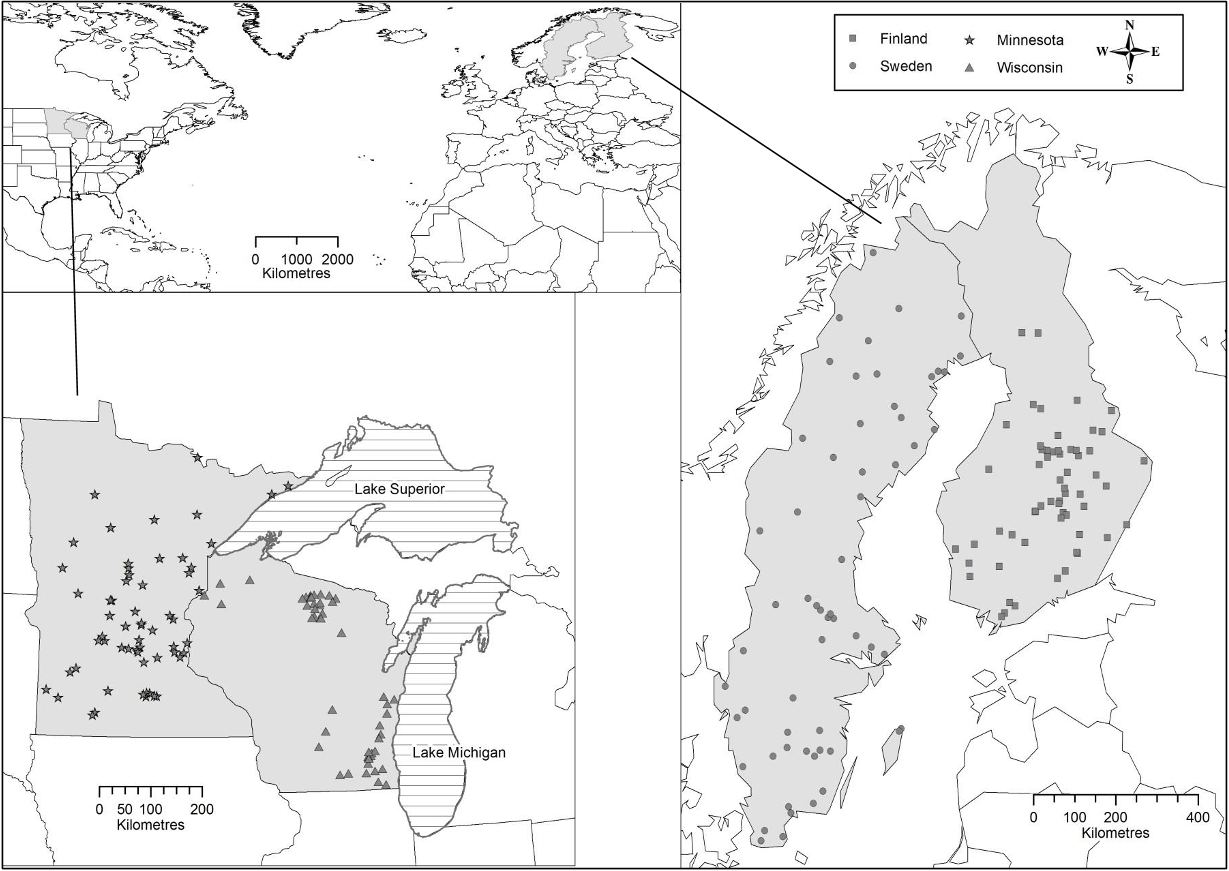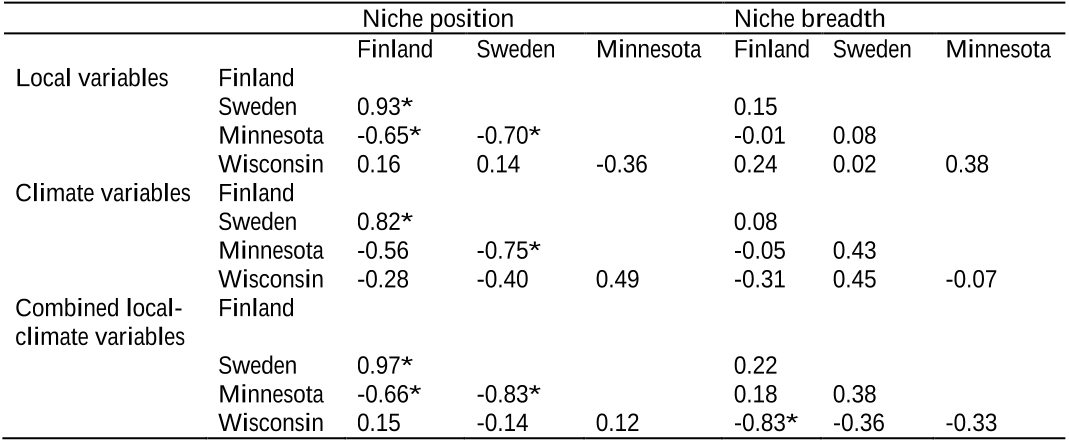
1
A comparative analysis reveals little evidence for niche conservatism in aquatic
1
macrophytes among four areas on two continents
2
3
Janne Alahuhta
1, 2*
, Frauke Ecke
3
, Lucinda B. Johnson
4
, Laura Sass
5
and Jani Heino
6
4
5
1
University of Oulu, Department of Geography, FI-90014 University of Oulu, Finland,
6
2
Finnish Environment Institute, Freshwater Centre, FI-90014 Oulu, Finland
7
3
Swedish University of Agricultural Sciences, Department of Aquatic Sciences and Assessment,
8
SWE-75007 Uppsala, Sweden
9
4
University of Minnesota Duluth, Natural Resources Research Institute, 5013 Miller Trunk
10
Highway, Duluth, MN 55811, USA
11
5
Illinois Natural History Survey, Prairie Research Institute, University of Illinois, 1816 South Oak
12
Street, Champaign, IL 61820, USA
13
6
Finnish Environment Institute, Natural Environment Centre, Biodiversity, FI-90014 Oulu, Finland
14
15
*Correspondence: Janne Alahuhta, University of Oulu, Department of Geography, P.O. Box 3000,
16
FI-90014, University of Oulu, Finland.
17
E-mail: janne.alahuhta@oulu.fi
18
19
20
21
22
23

2
SUMMARY
24
One of the most intriguing questions in current ecology is the extent to which the ecological niches
25
of species are conserved in space and time. Niche conservatism has mostly been studied using
26
coarse-scale data of species’ distributions, although it is at the local habitat scales where species’
27
responses to ecological variables primarily take place. We investigated the extent to which niches of
28
aquatic macrophytes are conserved among four study regions (i.e., Finland, Sweden and the US
29
states of Minnesota and Wisconsin) on two continents (i.e., Europe and North America) using data
30
for 11 species common to all the four study areas. We studied how ecological variables (i.e., local,
31
climate and spatial variables) explain variation in the distributions of these common species in the
32
four areas using species distribution modelling. In addition, we examined whether species’ niche
33
parameters vary among the study regions. Our results revealed large variation in both species’
34
responses to the studied ecological variables and in species’ niche parameters among the areas. We
35
found little evidence for niche conservatism in aquatic macrophytes, though local environmental
36
conditions among the studied areas were largely similar. This suggests that niche shifts, rather than
37
different environmental conditions, were responsible for variable responses of aquatic macrophytes
38
to local ecological variables. Local habitat niches of aquatic macrophytes are mainly driven by
39
variations in local environmental conditions, whereas their climate niches are more or less
40
conserved among regions. This highlights the need to study niche conservatism using local-scale
41
data to better understand whether species’ niches are conserved, because different niches (e.g., local
42
vs. climate) operating at various scales may show different degrees of conservatism. The extent to
43
which species’ niches are truly conserved has wide practical implications, including for instance,
44
predicting changes in species’ distributions in response to global change.
45
46
47

3
INTRODUCTION
48
49
The extent to which ecological niches of species are conserved in space and time has important
50
implications for a wide variety of biogeographical, ecological and evolutionary questions (Wiens
51
and Graham 2005, Pearman et al. 2008, Warren et al. 2008). These questions range from ecological
52
specialization to predicting changes in species’ distributions under global change (Wiens et al.
53
2010, Peterson 2011). For example, the reliability of predictions provided by species distribution
54
modelling is questionable if niche shifts have truly taken place in different areas (Bennett et al.
55
2010, Wiens et al. 2005, Wiens et al. 2010). The concept of niche conservatism assumes that a
56
niche of a species remains unchanged or changes only slowly over hundreds to millions of years
57
(Wiens and Graham 2005, Pearman et al. 2008). Furthermore, it assumes environmentally
58
unsuitable conditions can limit a species’ geographic range when niche conservatism prevails
59
(Wiens et al. 2010). Although this concept was coined relatively recently (Peterson et al. 1999), the
60
idea of ecological niche dates back to the early 20th century (Grinnell 1917, Elton 1927). Different
61
niche concepts exist (e.g., Hutchinson 1957), including fundamental, realised and existing
62
fundamental niches (see review by Chase and Leibold 2003). A fundamental niche describes the
63
environmental conditions and resources that a species is potentially able to use, whereas the realised
64
niche represents the part of the fundamental niche that the species actually occupies as a result of
65
biotic interactions (e.g., predation, competition and parasitism). The existing fundamental niche is
66
the portion of the fundamental niche that is represented across the area accessible to the species
67
(Peterson et al. 2011).
68
69
Niche conservatism, in relation to the geographical distributions of species, is typically studied
70
using coarse grid-based data of species’ ranges at broad spatial extents (Hawkins et al. 2014, Wasof
71

4
et al. 2015), while niche shifts in space and time are less frequently investigated using fine-grained
72
data (i.e., samples from local ecosystems) at broad spatial extents (but see Bennett et al. 2010,
73
Valdujo et al. 2013; Wasof et al. 2013). The ready availability of spatial data at medium to coarse
74
scales provides the opportunity to examine niche conservatism with respect to climatic variation
75
(Broennimann et al. 2007, Hawkins et al. 2014, Wasof et al. 2015); however, local habitat niche
76
studies require fine scale data not available across large regions. Fine-grained data enables
77
evaluating effects of the Eltonian noise hypothesis (Soberón and Nakamura 2009). This hypothesis
78
predicts that ecological interactions and species’ effects on resources define individual distributions
79
at fine spatial scales, whereas coarse-scaled abiotic factors structure distributions at broader scales.
80
81
Local-scale habitat variables can strongly affect species’ niche shifts even at broad spatial scales,
82
because it is the local habitat to which species respond in the first place (e.g. Wasof et al. 2013).
83
The phenomenon is exemplified by water acidity-related niches of freshwater diatoms which are
84
conserved across continents (Bennett et al. 2010). In many freshwater systems, local water
85
chemistry and habitat structure contribute equally or more strongly than climate to species’
86
distributions and community structure at broad spatial extents (Sharma et al. 2011, Alahuhta 2015).
87
These local habitat variables are also essential in determining species’ niche parameters, because
88
ecological gradients across freshwater ecosystems are often strong. For example, wide variation in
89
influential chemical and physical characteristics typically exists within a small geographical area
90
(Elser et al. 2007), and species respond to these major environmental gradients (Bennett et al. 2010,
91
Sharma et al. 2011, Alahuhta and Heino 2013). Typically, researchers are interested in knowing
92
how species’ niche positions and niche breadths vary in relation to local habitat variables
93
(Boulangeat et al. 2012, Wasof et al. 2013, Heino and Grönroos 2014), and potential niche shifts
94
can be observed from differences in these habitat niche parameters for the same species across
95

5
different areas (Ackerly 2003). Species niches are probably conserved if the distribution-
96
environment relationships are relatively similar for the same species across different study areas.
97
98
Recently, dispersal has also been included in the set of important processes affecting the
99
relationship between realised niches and geographical distributions (Soberón 2007, Soberón and
100
Nakamura 2009, Godsoe 2010, Peterson 2011). Dispersal is incorporated in the concept of spatial
101
processes, which depending on their dispersal abilities and possible geographical barriers allows
102
species to track variation in suitable habitats (Heino and de Mendoza, 2016). Species disperse
103
among suitable habitats that are structured as a network of habitat patches, varying in area, degree
104
of isolation and quality, surrounded by unsuitable habitats in the landscape (Hanski 1998, Leibold et
105
al. 2004). Spatial processes can constrain species’ responses to environmental variability, thus
106
relating directly to niche conservatism (Wiens et al. 2010). Spatial processes are especially
107
important in lake systems, because adaptation to living in water leads to the formation of well-
108
delimited populations surrounded by an inhospitable terrestrial matrix (Dahlgren and Ehrlén 2005,
109
Hortal et al. 2014). Lake macrophytes are a particularly suitable organismal group for the study of
110
spatial variability because these plants cannot actively move and have strong spatial structure even
111
within lake habitats (Nilsson et al. 2010, Arthaud et al. 2013). To date, it has been assumed that the
112
ecological niches of aquatic macrophytes remain unchanged in space (Chambers et al. 2008),
113
although no actual study has investigated whether or not the niches of aquatic macrophytes are
114
conserved at broad spatial extents.
115
116
Our study examines whether or not niches of aquatic macrophytes are conserved between different
117
geographical areas. Our primary aim is to investigate how ecological variables (i.e., local, climate
118
and spatial) explain variation in the distributions of common aquatic macrophyte species in four
119




